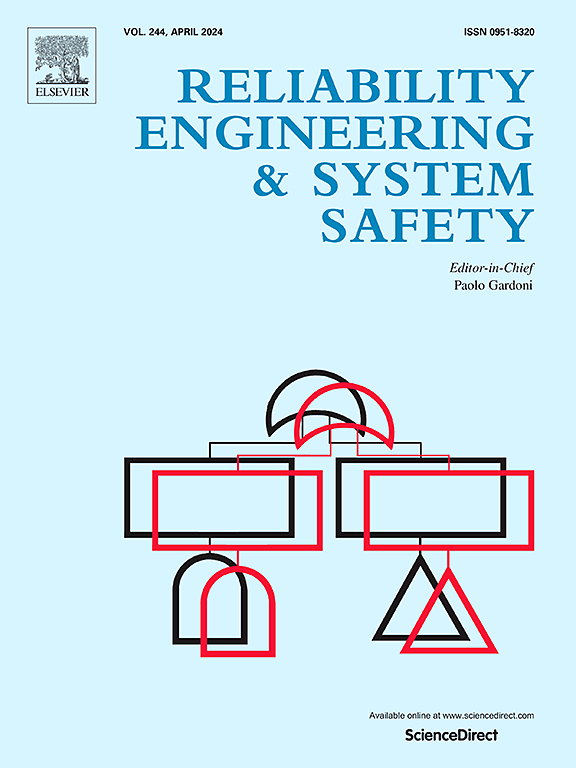深度神经网络不确定性量化的贝叶斯优化深度集成:钠快堆热分层建模的系统安全案例研究
IF 11
1区 工程技术
Q1 ENGINEERING, INDUSTRIAL
引用次数: 0
摘要
深度神经网络(dnn)在科学计算和工程系统仿真中越来越重要。在安全敏感的工程领域,深度神经网络的精确不确定性量化(UQ)至关重要。传统的深度集成(DE)方法虽然易于实现,但由于依赖于具有不同权值初始化的固定体系结构,常常存在校准不确定性估计差和预测精度有限的问题。为了解决这些问题,我们引入了一个结合贝叶斯优化(BO)和DE的工作流。该工作流是模块化的,可扩展的,并且集成了用Sobol序列初始化的并行BO,以单独优化每个集成成员的超参数。该方法增强了集合多样性,提高了预测精度,并提供了可靠的不确定性估计。我们在钠快堆热分层建模案例研究中评估了提出的BODE方法,在该案例中,我们使用密集连接的卷积神经网络来预测考虑数据噪声的反应堆瞬态期间的湍流粘度。我们将其性能与几种优化方法进行了基准测试,包括基线深度集成、进化算法优化集成、通过随机搜索结合贪婪选择形成的集成以及使用随机初始化的BO集成。我们的结果证明了所开发的BODE方法的优越性能。在无噪声情况下,BODE显著减少了不正确的任意不确定性,并显著提高了预测准确性。在5%和10%高斯噪声的条件下,BODE自适应量化与数据噪声成比例的不确定性,与基线方法相比,可将均方根误差降低80%,并产生校准良好的预测区间。本文章由计算机程序翻译,如有差异,请以英文原文为准。
Bayesian Optimized Deep Ensemble for Uncertainty Quantification of Deep Neural Networks: a System Safety Case Study on Sodium Fast Reactor Thermal Stratification Modeling
Deep neural networks (DNNs) are increasingly important to scientific computing and engineering system simulations. Accurate uncertainty quantification (UQ) for DNNs is critical in safety-sensitive engineering domains. Traditional Deep Ensemble (DE) methods, while easy to implement, frequently suffer from poorly calibrated uncertainty estimates and limited predictive accuracy due to reliance on fixed architectures with varied weight initializations. To address these issues, we introduce a workflow that combines Bayesian Optimization (BO) and DE. The workflow is modular, scalable, and integrates parallel BO initialized with Sobol sequences to individually optimize the hyperparameters of each ensemble member. This method enhances ensemble diversity, improves predictive accuracy, and provides reliable uncertainty estimates.
We evaluate the proposed BODE approach in a sodium fast reactor thermal stratification modeling case study, where we used a densely connected convolutional neural network to predict turbulent viscosity during the reactor transient with consideration of data noise. We benchmark its performance against several optimization approaches, including baseline deep ensemble, evolutionary algorithm-optimized ensemble, ensemble formed via random search combined with greedy selection, and a BO ensemble using random initialization. Our results demonstrate superior performance of the developed BODE approach. In noise-free scenarios, BODE notably reduces incorrect aleatoric uncertainty and significantly enhances predictive accuracy. Under conditions of 5% and 10% Gaussian noise, BODE adaptively quantifies uncertainty proportional to data noise, achieving up to an 80% reduction in root mean square error compared to baseline methods and producing well-calibrated prediction intervals.
求助全文
通过发布文献求助,成功后即可免费获取论文全文。
去求助
来源期刊

Reliability Engineering & System Safety
管理科学-工程:工业
CiteScore
15.20
自引率
39.50%
发文量
621
审稿时长
67 days
期刊介绍:
Elsevier publishes Reliability Engineering & System Safety in association with the European Safety and Reliability Association and the Safety Engineering and Risk Analysis Division. The international journal is devoted to developing and applying methods to enhance the safety and reliability of complex technological systems, like nuclear power plants, chemical plants, hazardous waste facilities, space systems, offshore and maritime systems, transportation systems, constructed infrastructure, and manufacturing plants. The journal normally publishes only articles that involve the analysis of substantive problems related to the reliability of complex systems or present techniques and/or theoretical results that have a discernable relationship to the solution of such problems. An important aim is to balance academic material and practical applications.
 求助内容:
求助内容: 应助结果提醒方式:
应助结果提醒方式:


